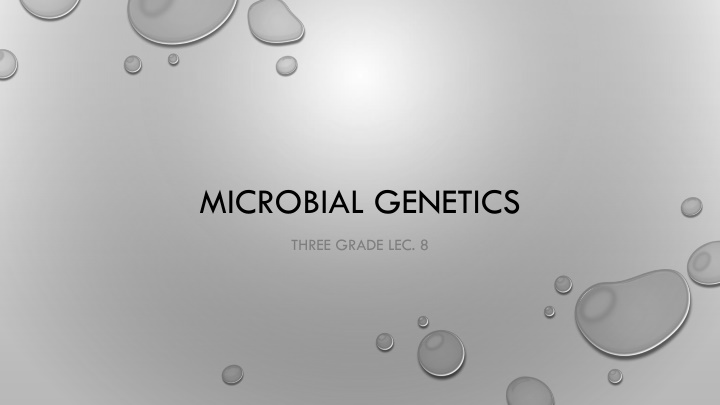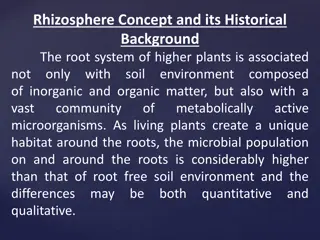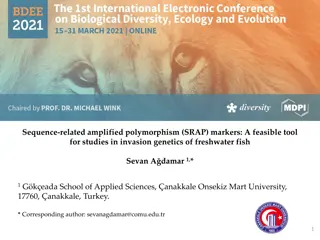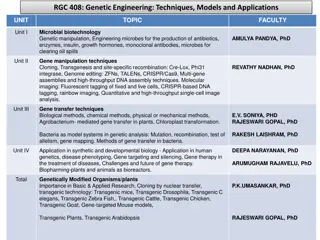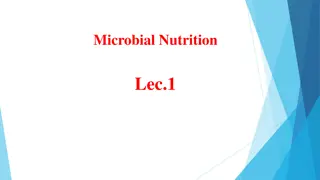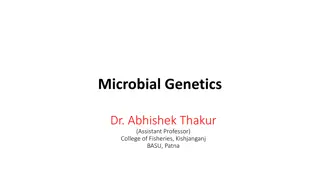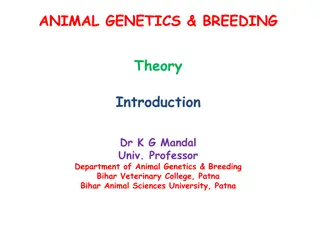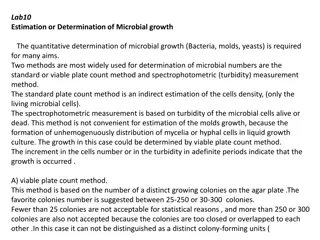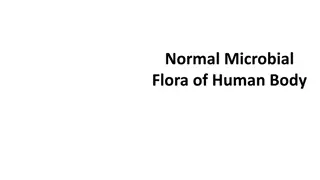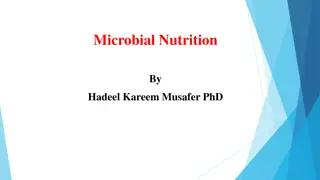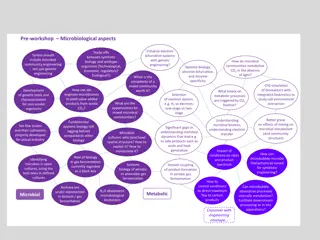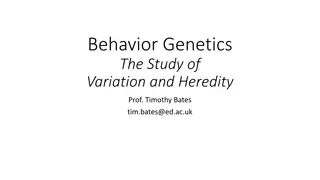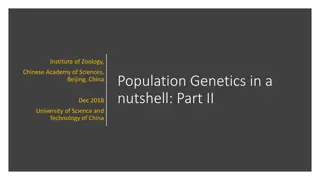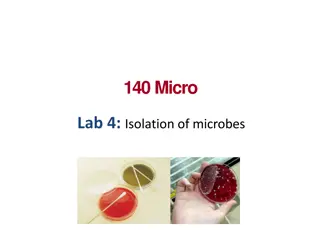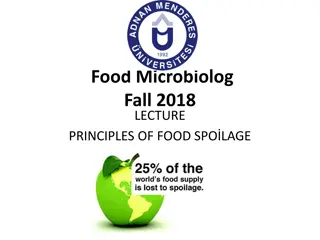Microbial Genetics - Transformation and Its Significance
Transformation, the uptake of DNA by bacteria, was pivotal in the study of bacterial genetics. It involves the transfer of genetic material, leading to genotype changes in the recipient cell. Natural transformation occurs in certain bacteria, aiding in genetic analysis and gene cloning. Competence and quorum sensing play essential roles in regulating this process. Understanding transformation sheds light on bacterial genetics and molecular biology.
Download Presentation

Please find below an Image/Link to download the presentation.
The content on the website is provided AS IS for your information and personal use only. It may not be sold, licensed, or shared on other websites without obtaining consent from the author.If you encounter any issues during the download, it is possible that the publisher has removed the file from their server.
You are allowed to download the files provided on this website for personal or commercial use, subject to the condition that they are used lawfully. All files are the property of their respective owners.
The content on the website is provided AS IS for your information and personal use only. It may not be sold, licensed, or shared on other websites without obtaining consent from the author.
E N D
Presentation Transcript
MICROBIAL GENETICS THREE GRADE LEC. 8
Transformation Transformation describes the uptake of naked DNA from the surrounding medium, and the change in genotype thus conferred upon the recipient cell the transformant. Transformation occurs naturally in many bacteria (e.g. Bacillus, Streptomyces and Haemophillus spp.) although competence (ability to take up exogenous DNA) is usually transient, being associated with a particular physiological state and requiring the expression of specific competence factors. Other species of bacteria, including E. coli, are refractory to natural transformation, but a state of competence can be induced artificially which allows DNA uptake; this has facilitated the use of E. coli for molecular cloning .
In a sense, it was the discovery of transformation, the uptake of DNA by a bacterial cell, that initiated the study of bacterial genetics and molecular biology as we know it today. It was in 1928 that Fred Griffith, working with pneumococcus (Streptococcus pneumoniae) discovered that a virulent strains could be restored to virulence by incubation with an extract from killed virulent cells. Sixteen years later, Avery, MacLeod and McCarty demonstrated that the transforming principle was DNA, which established the role of DNA as the hereditary material of the bacterial cell. Transformation has been important in genetic analysis of some species and more recently (and to a much greater extent) because of its key role in gene cloning. With the pneumococcus, cells spontaneously become competent to take up DNA. Such naturally-occurring transformation has been most studied in Bacillus subtilis and Haemophilus influenzae (as well as S. pneumoniae) and was for some time thought to be limited to these and related species. It is now known to be much more widespread. In particular, transformation contributes extensively to the antigenic variation observed in the gonococcus (Neisseria gonorrhoeae) through the transfer of pil genes coding for the major protein subunit of the surface appendages (pili) by which the bacteria attach to epithelial cells.
Although the number of species in which natural transformation has been demonstrated is still quite limited, it is likely that it occurs, albeit at a low level, in many other bacteria. The details of the process vary between species, but some generalizations are possible. Competence generally occurs at a specific stage of growth, most commonly in late log phase, just as the cells are entering stationary phase. This may be a response to cell density rather than (or as well as) growth phase. For example, in Bacillus subtilis, some of the genes involved in the development of competence are also involved in the early stages of sporulation. The development of competence at this stage is associated not only with nutrient depletion but also with the accumulation of specific secreted products (competence factors) which act via a two component regulatory system to stimulate the expression of other genes required for competence. Since the level of these competence factors is dependent on cell concentration, competence will only develop at high cell density. This is a form of quorum sensing, in which the response of an individual cell is governed by the concentration of bacteria in the surrounding medium.
Following the development of competence, double-stranded DNA fragments bind to receptors on the cell surface, but only one of the strands enters the cell. In some species, the process is selective for DNA from the same species, through a requirement for short species-specific sequences. For example, the uptake of DNA by the meningococcus (Neisseria meningitidis) is dependent on the presence of a specific 10-bp uptake sequence. The genome of N. meningitidis contains nearly 2000 copies of this sequence, which will only occur infrequently and by chance, in other genomes. Similarly, transformation of Haemophilus influenzae is facilitated by the presence of a 29-bp uptake sequence which occurs approximately 1500 times in the genome of H. influenzae. These organisms will therefore only be transformed efficiently with DNA from the same species.
On the other hand, B. subtilis and S. pneumoniae can take up virtually any linear DNA molecule. But taking up the DNA is only the start. If the cell is to become transformed in a stable manner, the new DNA has to be replicated and inherited. As here fragments of chromosomal DNA (rather than plasmids) are being considered, replication of the DNA will only happen if the incoming DNA is recombined with the host chromosome. This requires homology between the transforming DNA and the recipient chromosome. This does not constitute an absolute barrier to transformation with DNA from other species. Provided there is enough similarity in some regions of the chromosome, those segments of DNA can still undergo recombination with the recipient chromosome. The closer the taxonomic relationship, the more likely it is that they will be sufficiently similar. One example of this, with considerable practical significance, is the development of resistance to penicillin in S. pneumoniae. This appears to have occurred by the replacement of part of the genes coding for the penicillin target enzymes with corresponding DNA from naturally-resistant oral streptococci.
Natural transformation is of limited usefulness for artificial genetic modification of bacteria, mainly because it works best with linear DNA fragments rather than the circular plasmid DNA that is used in genetic modification. For introducing foreign genes into a bacterial host, various techniques are used to induce an artificial state of competence. Alternatively, a mixture of cells and DNA may be briefly subjected to a high voltage which enables the DNA to enter the cell (a process known as electroporation). Although the mechanisms involved are quite different, they all share the characteristic feature of the uptake of naked DNA by the cells and are therefore also referred to as transformation. Bacteria can be transformed with DNA extracted from a bacterial virus rather than from another bacterium. This process is known as transfection. If the DNA is from a lytic bacteriophage, transfection leads to virus production and can be measured by the standard phage plaque assay . Transfection is useful for studying the mechanism of transformation and recombination because the small size of phage genomes allows for the isolation of a nearly homogeneous population of DNA molecules. By contrast, in conventional transformation, the transforming DNA is typically a random assortment of chromosomal DNA of various lengths, and this tends to complicate experiments designed to study the mechanism of transformation.
